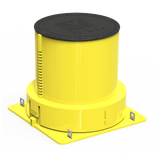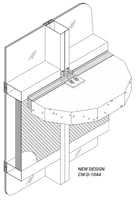Safing Spray is a higher solids, elastomeric coating used in perimeter fire barrier systems. It is...
STI News
 Much advancement has been made in the area of perimeter fire barrier systems over the past decade. A perimeter fire barrier is an assemblage of products installed at the building’s perimeter to prevent the interior spread of fire through the gap between the edge of the fire-rated floor assembly and a non-rated exterior wall. With the 2004 publication of the test method, ASTM E2307, “Standard Test Method for Determining the Fire Resistance of Perimeter Fire Barrier Systems Using Intermediate-Scale, Multi-Story Test Apparatus (ISMA)”, listing directories from third-party laboratories such as UL spawned complete categories of systems for different facades.
Much advancement has been made in the area of perimeter fire barrier systems over the past decade. A perimeter fire barrier is an assemblage of products installed at the building’s perimeter to prevent the interior spread of fire through the gap between the edge of the fire-rated floor assembly and a non-rated exterior wall. With the 2004 publication of the test method, ASTM E2307, “Standard Test Method for Determining the Fire Resistance of Perimeter Fire Barrier Systems Using Intermediate-Scale, Multi-Story Test Apparatus (ISMA)”, listing directories from third-party laboratories such as UL spawned complete categories of systems for different facades.
The ASTM E2307 test method was codified in the 2006 Edition of the International Building Code (IBC) in Chapter 7. The code requirement built upon the concept of maintaining the continuity of the fire-resistance rated floor assembly out to the exterior wall, which had historically been contained in many legacy building codes. Using the ISMA apparatus, a two-story furnace structure complete with an exterior burner, was an excellent method to simulate the effects of high-rise fire situations. The strength of this method is that it simulates fire induced window breaks, which allow a flame plume to escape and attack directly on the exterior of the wall while simultaneously attacking the bottom of the floor, the safing system installed into the gap, and the interior of the exterior wall. The severity of such a fire situation highlights the importance of a properly designed and installed perimeter fire barrier system.
UL, with more than 100 years of fire test experience, is the premier thirdparty testing agency for perimeter fire barriers due to their experience with the interrelated building components.
While the test itself is an excellent indicator of the ability of the system to resist flame passage for a time period equal to the hourly fire resistance rating of the floor, there is an additional but critical consideration that is often overlooked.
In curtain wall construction, the attachment of the exterior wall to the building is via connection points or anchors located at the edge of slab. The connection points are typically metal, made from either steel or aluminum. Steel is inherently very fire resistant, although it can deflect or deform due to thermal expansion under fire conditions. Aluminum has a melting point of approximately 1,200°F (649°C), although it loses significant strength at much lower temperatures. The safing system also provides protection to such anchor or connection points when properly designed.
If connection points for curtain wall are not properly protected, there is a significant risk of a panel shedding event. Should curtain wall sections fall away from the building, they could put building occupants attempting safe egress or first responders in the immediate area at significant risk.

Although not directly related to fire, provisions within ASCE 7, “Minimum Design Loads for Buildings and Other Structures” make extensive references in Section 9.5 to the concept of preventing connections from failing under seismic conditions to prevent panel shedding. Fire protection is not well defined, but many professionals have correlated the requirements imposed for seismic conditions for hazard mitigation.
When the connections or anchors attach to the top of the floor, the safing system is installed continuously beneath the connection points and this provides protection from direct flame impingement. Side-mounted connection points are also protected, but care should be exercised to ensure that the safing system in these locations extends to the bottom of the anchor or connection such that no portion remains exposed. Occasionally, connections, anchors, or even structural supports such as kickers or embeds may be located below the floor and thus exposed to direct flame impingement under fire exposure conditions. In such scenarios, there is a definite need to provide fire protection.
The IBC is somewhat unclear in this area, but there are other sources that provide instruction as to what should be done to remediate a potentially unsafe condition. The UL Guide Information for the Perimeter Fire Barrier System (XHDG) category states that, “Curtain wall spandrel panel dead-load anchors located below the concrete floor should be protected from direct fire exposure. When lateral anchors or braces are required to be used with the curtain wall spandrel panels, the lateral anchors or braces located beneath the concrete floor should also be protected from direct fire exposure. The protection for the anchors and braces may consist of a fire-resistive ceiling membrane, spray-applied fire resistive material, or other protective material with known hourly fire resistive properties.” With unmatched expertise with fire safety in the built environment, UL understands the criticality and complexity associated with fire protection in such situations.
The 2010 Edition of the Florida Building Code acknowledged the importance of protecting curtain wall connections in Chapter 24, Section 2416.6. Therein, it stated that connections “shall be provided with fire protection from the floor below with fire-resistant materials having a fire rating equivalent to that of the floor.”
While these requirements make it clear that connections must be fire protected, they are admittedly somewhat vague. This has left the fire protection industry to devise various methods, largely untested and based on engineering analysis, to provide some level of protection.
Recently, STI, the industry leader in testing UL Certified perimeter fire barrier systems, developed a patented method to protect exposed curtain wall connections.

In the absence of a clear test standard, STI worked in conjunction with UL to devise a methodology to evaluate curtain wall connection protection. The investigation included a series of fire tests to evaluate the connection protection concept and compare it to traditional fire protection materials, including spray-applied fire-resistive materials (SFRM), which resulted in the establishment of the XHDI category for “Accessories for Perimeter Fire Containment Systems” and the publication of specific systems within the XHDG category, that include STI’s connection protection systems.
The topic of curtain wall connection fire protection is emerging, and should not be taken lightly. The safety afforded by systems that properly protect the connections is paramount in the built environment. It is recommended that third-party listings that show and describe the connections or anchors should be selected. Listings that do not clearly describe the connections may not adequately address concerns, and should be avoided. STI’s Technical Services team comprised of Fire Protection Engineers and Applications Engineers stand ready to help assist with any questions that might arise regarding this important subject matter.



